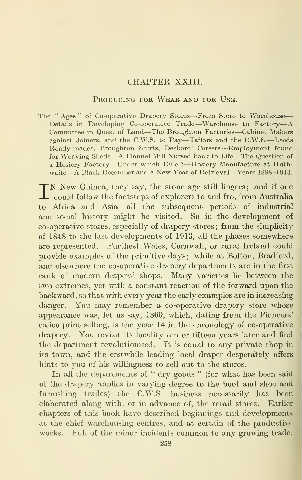Page 328 - The_story_of_the_C._W._S._The_jubilee_history_of_the_cooperative_wholesale_society,_limited._1863-1913_(IA_storyofcwsjubill00redf) (1)_Neat
P. 328
A
CHAPTER XXIII. —
Producing for Wear and for Use.
The " Ages " of Co-operative Drapery Stores—From Store to Warelioxise
Details in Developing Co-operative Trade—Warehouse to Factory—
Committee in Quest of Land—The Broughton Factories—Cabinet Makers
against Joiners, and the C.W.S. to Pay^—Tailors and the C.W.S.—Leeds
Ready-mades, Broughton Shirts, Desboro' Corsets—Employment found
for Weaving Sheds—A Flannel Mill Nursed back to Life—The Question of
a Hosiery Factory—Under wliich Rule ?—Hosiery Manufacture at Huth-
waite—A Black December and a New Year of Retrieval—Years 1888-1913.
IN New Guinea, they say, the stone age still lingers; and if one
could follow the footsteps of explorers to and fro, from Austraha
to Africa and Asia, all the subsequent periods of industrial
and social history might be visited. So m the development of
co-operative stores, especially of drapery stores ; from the simphcity
of 1848 to the last developments of 1913, all the phases somewhere
are represented. Furthest Wales, Cornwall, or rural Ireland could
provide examples of the primitive days ; while at Bolton, Bradford,
and elsewhere the co-operative drapery departments are in the first
rank of modern drapers' shops. Many varieties lie between the
two extremes, yet with a constant reaction of the forward upon the
backward, so that with every year the early examples are in mcreasing
danger. You may remember a co-operative drapery store whose
appearance was, let us say, 1860, which, dating from the Pioneers'
caUco print selling, is the 5'"ear 14 in the chronology of co-operative
drapery. You revisit its locality ten or fifteen years later and find
the department revolutionised. It is equal to any private shop in
its town, and the erstwhile leading local draper desperately offers
hints to you of his willingness to sell out to the stores.
" "
In all Ihe departments of dry goods (for what has been said
of the drapery appUes m varying degree to the boot and shoe and
furnishing trades) the C.W.S. business necessarily has been
elaborated along with, or in advance of, the retail stores. EarUer
chapters of this book have described begmnings and developments
at the chief warehousing centres, and at certain of the productive
works. Full of the minor incidents common to any growing trade,
258

